Longqi Yang
Conversational User-AI Intervention: A Study on Prompt Rewriting for Improved LLM Response Generation
Mar 21, 2025Abstract:Human-LLM conversations are increasingly becoming more pervasive in peoples' professional and personal lives, yet many users still struggle to elicit helpful responses from LLM Chatbots. One of the reasons for this issue is users' lack of understanding in crafting effective prompts that accurately convey their information needs. Meanwhile, the existence of real-world conversational datasets on the one hand, and the text understanding faculties of LLMs on the other, present a unique opportunity to study this problem, and its potential solutions at scale. Thus, in this paper we present the first LLM-centric study of real human-AI chatbot conversations, focused on investigating aspects in which user queries fall short of expressing information needs, and the potential of using LLMs to rewrite suboptimal user prompts. Our findings demonstrate that rephrasing ineffective prompts can elicit better responses from a conversational system, while preserving the user's original intent. Notably, the performance of rewrites improves in longer conversations, where contextual inferences about user needs can be made more accurately. Additionally, we observe that LLMs often need to -- and inherently do -- make \emph{plausible} assumptions about a user's intentions and goals when interpreting prompts. Our findings largely hold true across conversational domains, user intents, and LLMs of varying sizes and families, indicating the promise of using prompt rewriting as a solution for better human-AI interactions.
Group Preference Alignment: Customized LLM Response Generation from In-Situ Conversations
Mar 11, 2025Abstract:LLMs often fail to meet the specialized needs of distinct user groups due to their one-size-fits-all training paradigm \cite{lucy-etal-2024-one} and there is limited research on what personalization aspects each group expect. To address these limitations, we propose a group-aware personalization framework, Group Preference Alignment (GPA), that identifies context-specific variations in conversational preferences across user groups and then steers LLMs to address those preferences. Our approach consists of two steps: (1) Group-Aware Preference Extraction, where maximally divergent user-group preferences are extracted from real-world conversation logs and distilled into interpretable rubrics, and (2) Tailored Response Generation, which leverages these rubrics through two methods: a) Context-Tuned Inference (GAP-CT), that dynamically adjusts responses via context-dependent prompt instructions, and b) Rubric-Finetuning Inference (GPA-FT), which uses the rubrics to generate contrastive synthetic data for personalization of group-specific models via alignment. Experiments demonstrate that our framework significantly improves alignment of the output with respect to user preferences and outperforms baseline methods, while maintaining robust performance on standard benchmarks.
GenTool: Enhancing Tool Generalization in Language Models through Zero-to-One and Weak-to-Strong Simulation
Feb 26, 2025Abstract:Large Language Models (LLMs) can enhance their capabilities as AI assistants by integrating external tools, allowing them to access a wider range of information. While recent LLMs are typically fine-tuned with tool usage examples during supervised fine-tuning (SFT), questions remain about their ability to develop robust tool-usage skills and can effectively generalize to unseen queries and tools. In this work, we present GenTool, a novel training framework that prepares LLMs for diverse generalization challenges in tool utilization. Our approach addresses two fundamental dimensions critical for real-world applications: Zero-to-One Generalization, enabling the model to address queries initially lacking a suitable tool by adopting and utilizing one when it becomes available, and Weak-to-Strong Generalization, allowing models to leverage enhanced versions of existing tools to solve queries. To achieve this, we develop synthetic training data simulating these two dimensions of tool usage and introduce a two-stage fine-tuning approach: optimizing tool ranking, then refining tool selection. Through extensive experiments across four generalization scenarios, we demonstrate that our method significantly enhances the tool-usage capabilities of LLMs ranging from 1B to 8B parameters, achieving performance that surpasses GPT-4o. Furthermore, our analysis also provides valuable insights into the challenges LLMs encounter in tool generalization.
WildFeedback: Aligning LLMs With In-situ User Interactions And Feedback
Aug 28, 2024



Abstract:As large language models (LLMs) continue to advance, aligning these models with human preferences has emerged as a critical challenge. Traditional alignment methods, relying on human or LLM annotated datasets, are limited by their resource-intensive nature, inherent subjectivity, and the risk of feedback loops that amplify model biases. To overcome these limitations, we introduce WildFeedback, a novel framework that leverages real-time, in-situ user interactions to create preference datasets that more accurately reflect authentic human values. WildFeedback operates through a three-step process: feedback signal identification, preference data construction, and user-guided evaluation. We applied this framework to a large corpus of user-LLM conversations, resulting in a rich preference dataset that reflects genuine user preferences. This dataset captures the nuances of user preferences by identifying and classifying feedback signals within natural conversations, thereby enabling the construction of more representative and context-sensitive alignment data. Our extensive experiments demonstrate that LLMs fine-tuned on WildFeedback exhibit significantly improved alignment with user preferences, as evidenced by both traditional benchmarks and our proposed user-guided evaluation. By incorporating real-time feedback from actual users, WildFeedback addresses the scalability, subjectivity, and bias challenges that plague existing approaches, marking a significant step toward developing LLMs that are more responsive to the diverse and evolving needs of their users. In summary, WildFeedback offers a robust, scalable solution for aligning LLMs with true human values, setting a new standard for the development and evaluation of user-centric language models.
Interpretable User Satisfaction Estimation for Conversational Systems with Large Language Models
Mar 19, 2024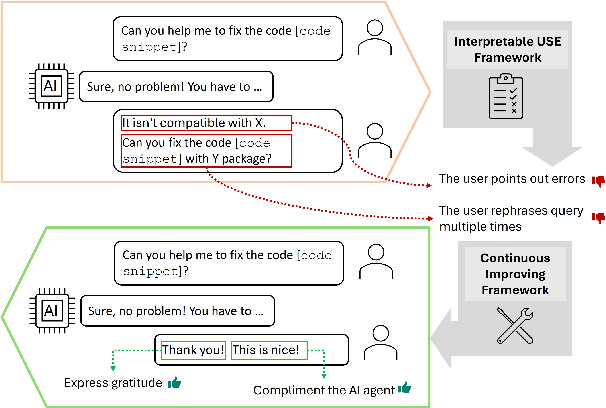

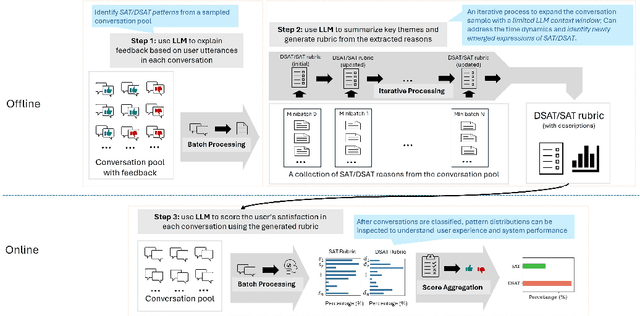

Abstract:Accurate and interpretable user satisfaction estimation (USE) is critical for understanding, evaluating, and continuously improving conversational systems. Users express their satisfaction or dissatisfaction with diverse conversational patterns in both general-purpose (ChatGPT and Bing Copilot) and task-oriented (customer service chatbot) conversational systems. Existing approaches based on featurized ML models or text embeddings fall short in extracting generalizable patterns and are hard to interpret. In this work, we show that LLMs can extract interpretable signals of user satisfaction from their natural language utterances more effectively than embedding-based approaches. Moreover, an LLM can be tailored for USE via an iterative prompting framework using supervision from labeled examples. The resulting method, Supervised Prompting for User satisfaction Rubrics (SPUR), not only has higher accuracy but is more interpretable as it scores user satisfaction via learned rubrics with a detailed breakdown.
TnT-LLM: Text Mining at Scale with Large Language Models
Mar 18, 2024Abstract:Transforming unstructured text into structured and meaningful forms, organized by useful category labels, is a fundamental step in text mining for downstream analysis and application. However, most existing methods for producing label taxonomies and building text-based label classifiers still rely heavily on domain expertise and manual curation, making the process expensive and time-consuming. This is particularly challenging when the label space is under-specified and large-scale data annotations are unavailable. In this paper, we address these challenges with Large Language Models (LLMs), whose prompt-based interface facilitates the induction and use of large-scale pseudo labels. We propose TnT-LLM, a two-phase framework that employs LLMs to automate the process of end-to-end label generation and assignment with minimal human effort for any given use-case. In the first phase, we introduce a zero-shot, multi-stage reasoning approach which enables LLMs to produce and refine a label taxonomy iteratively. In the second phase, LLMs are used as data labelers that yield training samples so that lightweight supervised classifiers can be reliably built, deployed, and served at scale. We apply TnT-LLM to the analysis of user intent and conversational domain for Bing Copilot (formerly Bing Chat), an open-domain chat-based search engine. Extensive experiments using both human and automatic evaluation metrics demonstrate that TnT-LLM generates more accurate and relevant label taxonomies when compared against state-of-the-art baselines, and achieves a favorable balance between accuracy and efficiency for classification at scale. We also share our practical experiences and insights on the challenges and opportunities of using LLMs for large-scale text mining in real-world applications.
PEARL: Personalizing Large Language Model Writing Assistants with Generation-Calibrated Retrievers
Nov 15, 2023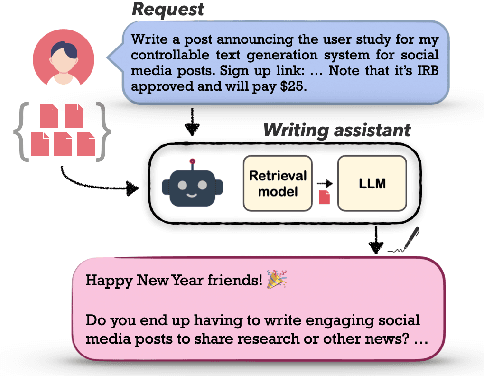

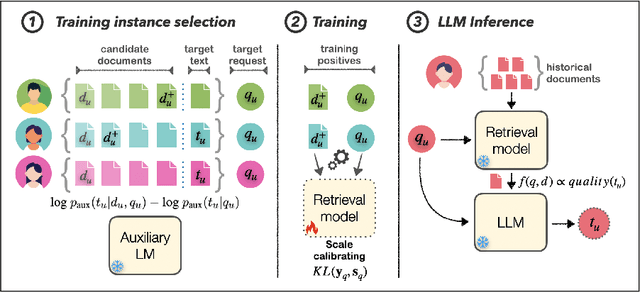
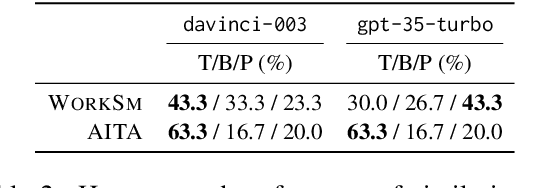
Abstract:Powerful large language models have facilitated the development of writing assistants that promise to significantly improve the quality and efficiency of composition and communication. However, a barrier to effective assistance is the lack of personalization in LLM outputs to the author's communication style and specialized knowledge. In this paper, we address this challenge by proposing PEARL, a retrieval-augmented LLM writing assistant personalized with a generation-calibrated retriever. Our retriever is trained to select historic user-authored documents for prompt augmentation, such that they are likely to best personalize LLM generations for a user request. We propose two key novelties for training our retriever: 1) A training data selection method that identifies user requests likely to benefit from personalization and documents that provide that benefit; and 2) A scale-calibrating KL-divergence objective that ensures that our retriever closely tracks the benefit of a document for personalized generation. We demonstrate the effectiveness of PEARL in generating personalized workplace social media posts and Reddit comments. Finally, we showcase the potential of a generation-calibrated retriever to double as a performance predictor and further improve low-quality generations via LLM chaining.
Leveraging Large Language Models for Collective Decision-Making
Nov 03, 2023



Abstract:In various work contexts, such as meeting scheduling, collaborating, and project planning, collective decision-making is essential but often challenging due to diverse individual preferences, varying work focuses, and power dynamics among members. To address this, we propose a system leveraging Large Language Models (LLMs) to facilitate group decision-making by managing conversations and balancing preferences among individuals. Our system extracts individual preferences and suggests options that satisfy a significant portion of the members. We apply this system to corporate meeting scheduling. We create synthetic employee profiles and simulate conversations at scale, leveraging LLMs to evaluate the system. Our results indicate efficient coordination with reduced interactions between members and the LLM-based system. The system also effectively refines proposed options over time, ensuring their quality and equity. Finally, we conduct a survey study involving human participants to assess our system's ability to aggregate preferences and reasoning. Our findings show that the system exhibits strong performance in both dimensions.
S3-DST: Structured Open-Domain Dialogue Segmentation and State Tracking in the Era of LLMs
Sep 16, 2023
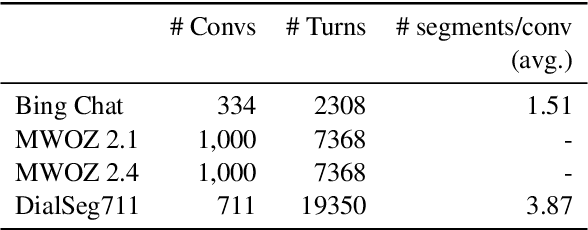


Abstract:The traditional Dialogue State Tracking (DST) problem aims to track user preferences and intents in user-agent conversations. While sufficient for task-oriented dialogue systems supporting narrow domain applications, the advent of Large Language Model (LLM)-based chat systems has introduced many real-world intricacies in open-domain dialogues. These intricacies manifest in the form of increased complexity in contextual interactions, extended dialogue sessions encompassing a diverse array of topics, and more frequent contextual shifts. To handle these intricacies arising from evolving LLM-based chat systems, we propose joint dialogue segmentation and state tracking per segment in open-domain dialogue systems. Assuming a zero-shot setting appropriate to a true open-domain dialogue system, we propose S3-DST, a structured prompting technique that harnesses Pre-Analytical Recollection, a novel grounding mechanism we designed for improving long context tracking. To demonstrate the efficacy of our proposed approach in joint segmentation and state tracking, we evaluate S3-DST on a proprietary anonymized open-domain dialogue dataset, as well as publicly available DST and segmentation datasets. Across all datasets and settings, S3-DST consistently outperforms the state-of-the-art, demonstrating its potency and robustness the next generation of LLM-based chat systems.
Using Large Language Models to Generate, Validate, and Apply User Intent Taxonomies
Sep 14, 2023



Abstract:Log data can reveal valuable information about how users interact with web search services, what they want, and how satisfied they are. However, analyzing user intents in log data is not easy, especially for new forms of web search such as AI-driven chat. To understand user intents from log data, we need a way to label them with meaningful categories that capture their diversity and dynamics. Existing methods rely on manual or ML-based labeling, which are either expensive or inflexible for large and changing datasets. We propose a novel solution using large language models (LLMs), which can generate rich and relevant concepts, descriptions, and examples for user intents. However, using LLMs to generate a user intent taxonomy and apply it to do log analysis can be problematic for two main reasons: such a taxonomy is not externally validated, and there may be an undesirable feedback loop. To overcome these issues, we propose a new methodology with human experts and assessors to verify the quality of the LLM-generated taxonomy. We also present an end-to-end pipeline that uses an LLM with human-in-the-loop to produce, refine, and use labels for user intent analysis in log data. Our method offers a scalable and adaptable way to analyze user intents in web-scale log data with minimal human effort. We demonstrate its effectiveness by uncovering new insights into user intents from search and chat logs from Bing.
 Add to Chrome
Add to Chrome Add to Firefox
Add to Firefox Add to Edge
Add to Edge